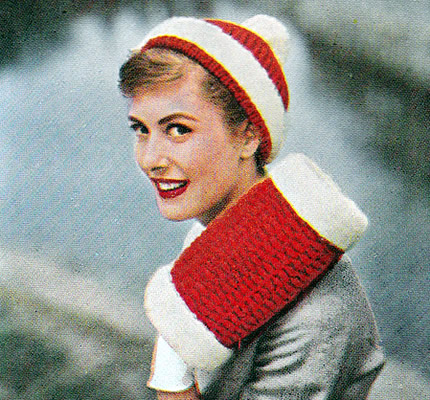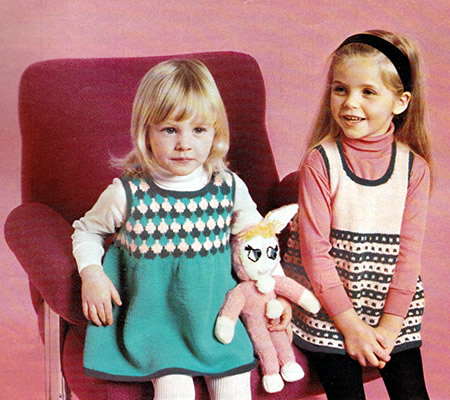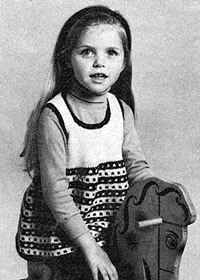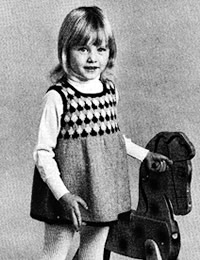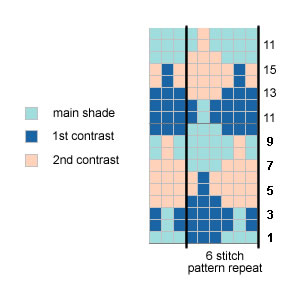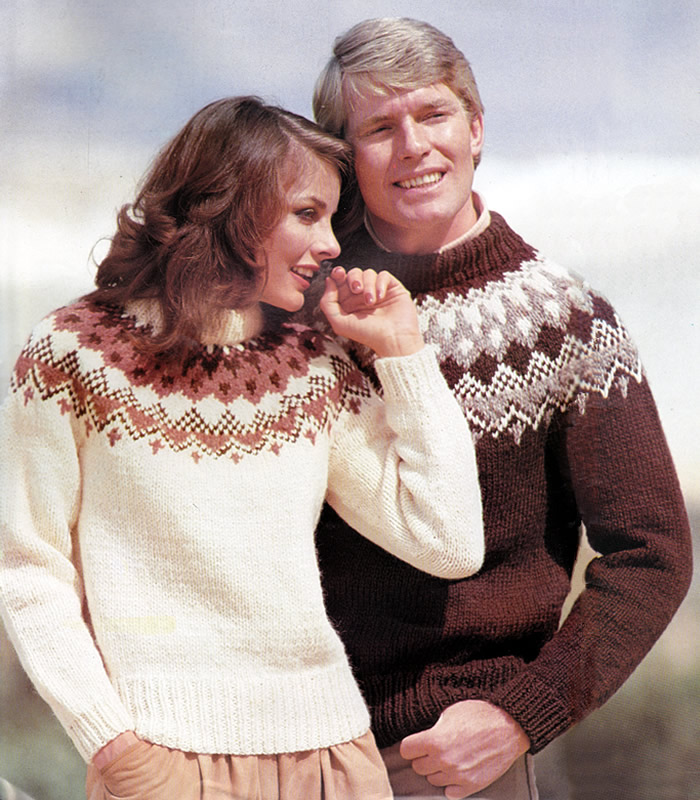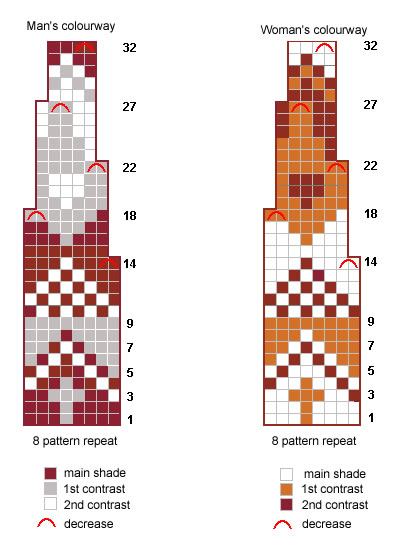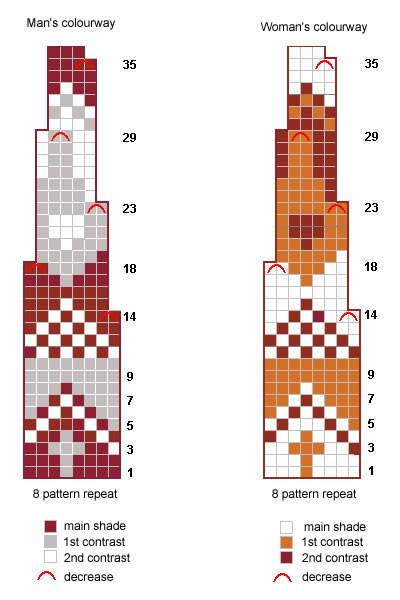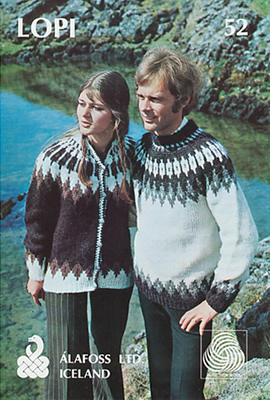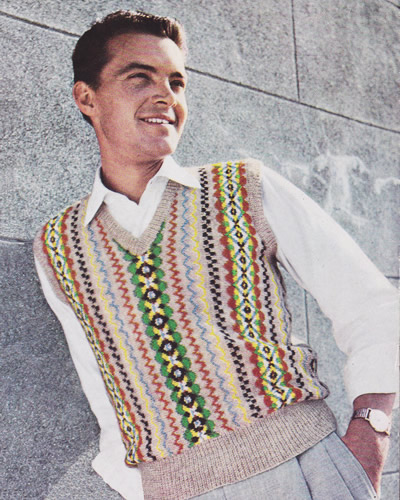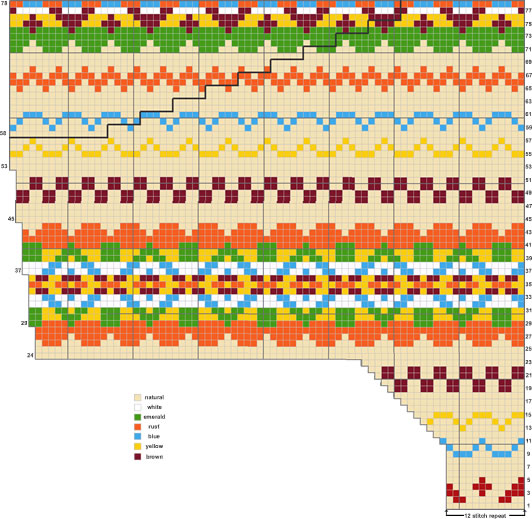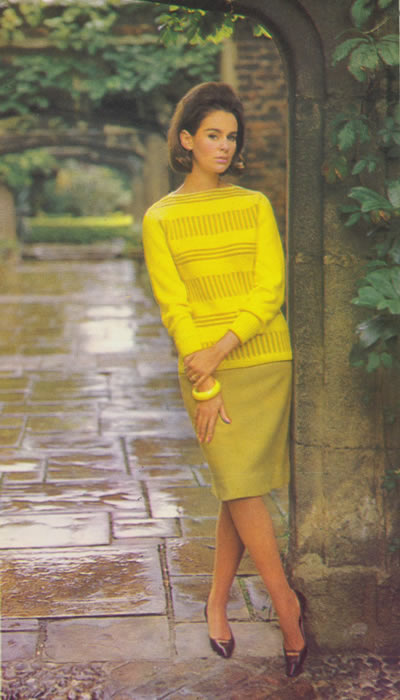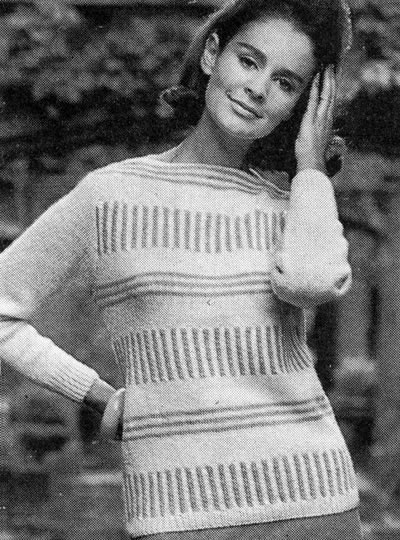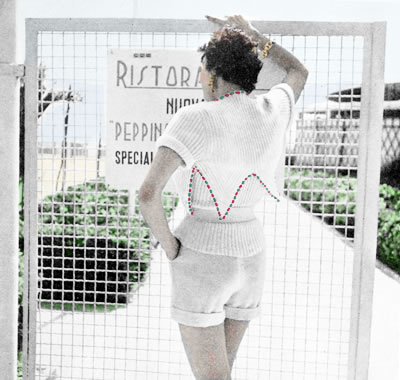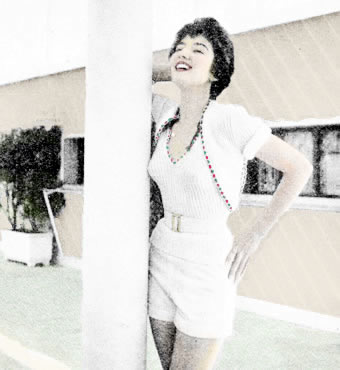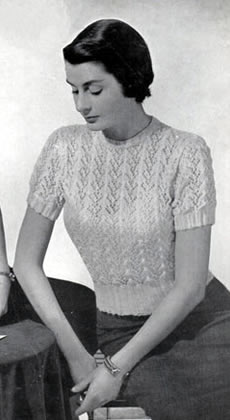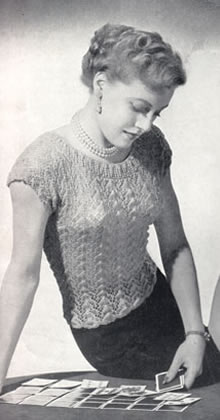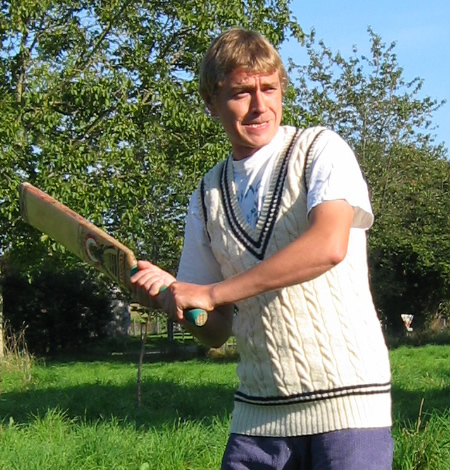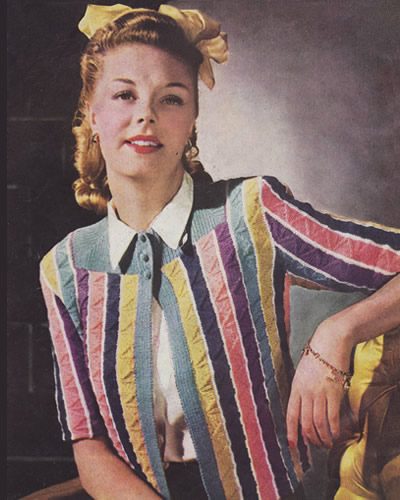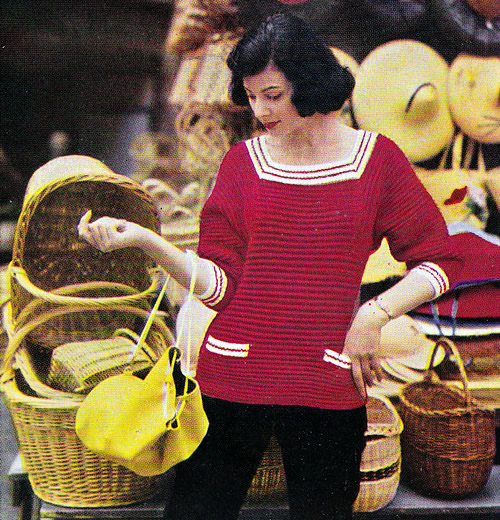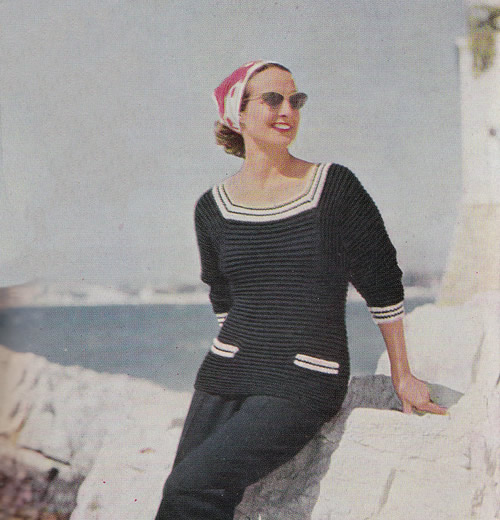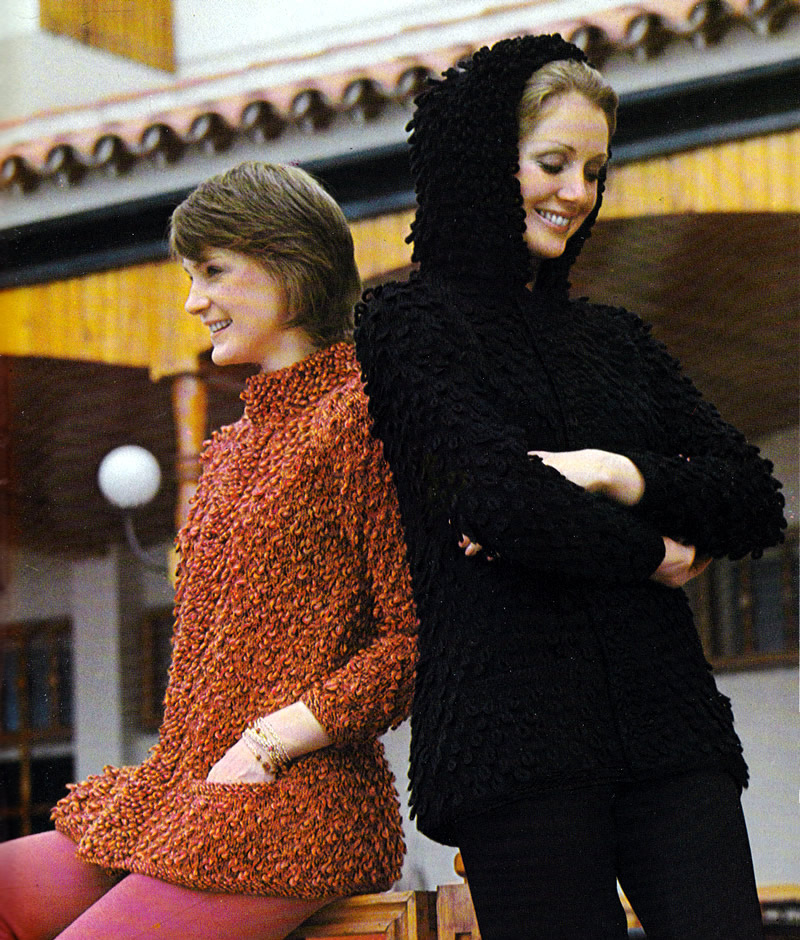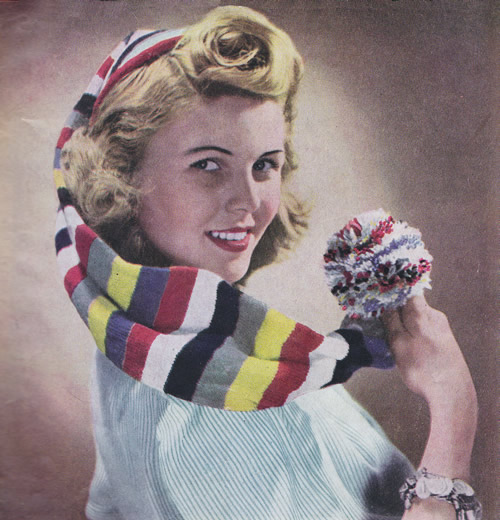Instructions.
The sweater is worked in a good range of sizes, intended to cover kids
and men, but could also fit women, making suitable length adjustments
in body and sleeve. Instructions for the larger sizes are shown in brackets.
Because of the layout for the different sizes, I recommend printing out
the instructions and underlining the size you have chosen to work in every
section that applies to that size (and maybe crossing through the other
inapplicable sections).
There are options for versions with and without sleeves (and with and
without team colours, of course).
Sweater Back
With No 10 (3¼mm) needles and main shade, cast on 77, 83,
89, 95, 99,
105, 111, 117,
121, 127 stitches.
**
1st row (right side facing): k1 *
p1, k1; repeat from * to end.
2nd row: p1 *
k1, p1; repeat from * to last stitch,
p1.
If not including contrast colours, Repeat 1st and 2nd rows 10
times then the 1st row again, and continue below with 24th (increase)
row.
If including contrast colours, repeat 1st and 2nd rows once.
Join in second colour and repeat 1st and 2nd rows once.
Break off contrast, and continuing in main shade, repeat 1st and 2nd rows
5 times.
Join in contrast once again and repeat 1st and 2nd rows once.
Break off contrast, and continuing in main shade, repeat 1st and 2nd rows
twice, then the 1st row once.
**
Continue with main shade for the remainder of the Back.
24th (increase) row: p3 (4,
7, 8, 6,
5, 6, 9,
7, 8); *
increase once in the next stitch purlwise, p1; repeat from *
to the last 2 (3, 6,
7, 5, 4,
5, 8, 6,
7) stitches: p2 (3, 6,
7, 5, 4,
5, 8, 6,
7).
[113 (121, 127,
135, 143, 153,
161, 167, 175,
183) sts].
Change to No 8 (4mm) needles and proceed as follows:-
For three smallest sizes only (28, 30 and
32 inch chest):
***
1st row: k0 (4,
7); p2, *
slip the next 4 stitches on to a cable needle and hold at the back of
the work, k5 stitches, then k4 stitches from cable needle (this will now
termed C9B); p2, k7, p2; slip the next 5 stitches on to a cable needle
and hold at the front of the work, k4 stitches, then k5 stitches from
cable needle (this will now termed C9F); p2, k7, p2; repeat from *
to last 31 (35, 38)
stitches, C9B, p2, k7, p2, C9F, p2, k0 (4,
7).
2nd row: p0 (4,
7); k2, p9, k2, p7, k2, p9; *
k2, p7, k2, p9; repeat from * to last
2 (6, 9)
stitches, k2, p0 (4, 7).
3rd row: k0 (4,
7); p2, *
k9, p2, k7, p2; repeat from * to last
31 (35, 38)
stitches, k9, p2, k7, p2, k9, p2, k0 (4,
7).
4th row: p0 (4,
7); k2, p9, k2, p7, k2, p9, *
k2, p7, k2, p9, repeat from * to last
2 (6, 9)
stitches, k2, p0 (4, 7).
Repeat 3rd and 4th rows 4 times.
***
For the medium-small sizes only (34, and
36 inch chest):
***
1st row: k- (-,
-, 2, 6);
* p2, k7, p2, slip the next 4 stitches
on to a cable needle and hold at the back of the work, k5 stitches, then
k4 stitches from cable needle (this will now termed C9B); p2, k7, p2;
slip the next 5 stitches on to a cable needle and hold at the front of
the work, k4 stitches, then k5 stitches from cable needle (this will now
termed C9F); repeat from * to last
- (-, -,
13, 17) stitches, C9B, p2, k7, p2,
p2, k- (-, -,
2, 6).
2nd row: p- (-,
-, 2, 6);
k2, p7, k2; * p9, k2, p7, k2; repeat
from * to last - (-,
-, 2, 6)
stitches, p- (-, -,
2, 6).
3rd row: k- (-,
-, 2, 6);
* p2, k7, p2, k9; repeat from *
to last - (-, -,
13, 17) stitches, p2, k7, p2, k- (-,
-, 2, 6).
4th row: p- (-,
-, 2, 6);
k2, p7, k2; *p9, k2, p7, k2; repeat
from * to last - (-,
-, 2, 6)
stitches, p- (-, -,
2, 6).
Repeat 3rd and 4th rows 4 times.
***
For the three medium-large sizes only (38,
40 and 42 inch chest):
***
1st row: k- (-,
-, -, -,
0, 4, 7),
p2; * slip the next 5 stitches on
to a cable needle and hold at the front of the work, k4 stitches, then
k5 stitches from cable needle (this will now termed C9F); p2, k7, p2;
slip the next 4 stitches on to a cable needle and hold at the back of
the work, k5 stitches, then k4 stitches from cable needle (this will now
termed C9B); p2, k7, p2; repeat from *
to last - (-, -,
-, -, 31,
35, 38) stitches, C9F, p2, k7, p2,
C9B, p2, k- (-, -,
-, -, 0,
4, 7).
2nd row: p- (-,
-, -, -,
0, 4, 7);
k2, p9, k2, p7, k2, p9, * k2,
p7, k2, p9; repeat from * to last
- (-, -,
-, -, 2,
6, 9) stitches, k2, p- (-,
-, -, -,
0, 4, 7).
3rd row: k- (-,
-, -, -,
0, 4, 7);
p2, * k9, p2, k7, p2; repeat from
* to last - (-,
-, -, -,
31, 35, 38)
stitches, k9, p2, k7, p2, k9, p2, k- (-,
-, -, -,
0, 4, 7).
4th row: p- (-,
-, -, -,
0, 4, 7);
k2, p9, k2, p7, k2, p9, * k2, p7,
k2, p9, repeat from * to last - (-,
-, -, -,
2, 6, 9)
stitches, k2, p- (-, -,
-, -, 0,
4, 7).
Repeat 3rd and 4th rows 4 times.
***
For two largest sizes only (44 and 46 inch
chest):
***
1st row: k- (-,
-, -, -,
-, -, -,
2, 6);
* p2, k7, p2, slip the next 5 stitches
on to a cable needle and hold at the front of the work, k4 stitches, then
k5 stitches from cable needle (this will now termed C9F); p2, k7, p2;
slip the next 4 stitches on to a cable needle and hold at the back of
the work, k5 stitches, then k4 stitches from cable needle (this will now
termed C9B); repeat from * to last
- (-, -,
-, -, -,
-, -, 13,
17) stitches, p2, k7, p2, k- (-,
-, -, -,
-, -, -,
2, 6).
2nd row: p- (-,
-, -, -,
-, -, -,
2, 6),
k2, p7, k2; * p9, k2, p7, k2; repeat
from * to last - (-,
-, -, -,
-, -, -,
2, 6)
stitches, p- (-, -,
-, -, -,
-, -, 2,
6).
3rd row: k- (-,
-, -, -,
-, -, -,
2, 6);
* p2, k7,p2, k9; repeat from *
to last - (-, -,
-, -, -,
-, -, 13,
17) stitches, p2, k7, p2, k- (-,
-, -, -,
-, -, -,
2, 6).
4th row: p- (-,
-, -, -,
-, -, -,
2, 6);
k2, p7, k2; * p9, k2, p7, k2; repeat
from * to last - (-,
-, -, -,
-, -, -,
2, 6)
stitches, p- (-, -,
-, -, -,
-, -, 2,
6).
Repeat 3rd and 4th rows 4 times.
***
FOR ALL 10 sizes
Under each separate section for the size you are working, the instructions
embedded between *** to ***
forms the pattern.
Keeping continuity of pattern (throughout) continue until work measures
11½ (13, 14,
13½, 15½, 15½,
15½, 15½, 15, 16)
inches from the beginning, ending on a wrong side row.
Shape armholes:
Cast off 7 stitches in pattern at the beginning of the next 2 rows.
[99 (107, 113,
121, 129, 139,
147, 153, 161,
169) sts].
****
Work 9 (11, 13,
15, 10, 13,
17, 18, 22,
24) rows, decreasing 1 stitch at each end of every row.
[81 (85, 87,
91, 109, 113,
113, 117, 117,
121) sts].
Continue without shaping until armhole measures 7½ (8,
8, 8½, 10½,
10½, 10½, 10½,
11, 11) inches, ending on the wrong
side.
Shape shoulders:
Cast off 12 (12, 12,
13, 18, 17,
17, 18, 18,
18) stitches in pattern at the beginning of the next 2 rows.
Cast off 12 (12, 13,
14, 18, 18,
18, 19, 19,
19) stitches in pattern at the beginning of the next 2 rows.
Cast off remaining 33 (37, 37,
37, 37, 43,
43, 43, 43,
47) stitches in pattern.
Sweater Front
Work exactly as given for back until ****
is reached in the armhole shaping section.
Divide for neck:
Next row: k2tog, pattern 45 (49,
52, 56, 60,
65, 69, 72,
76, 80) stitches, k2tog; turn.
Working on these 47 (51, 54,
58, 62, 67,
71, 74, 78,
82) stitches only, proceed as follows:
Next row: pattern to last 2 stitches,
p2tog.
[46 (50, 53,
57, 61, 66,
70, 73, 77,
81) sts]
Work 7 (9, 11,
13, 5, 11,
15, 16, 13,
21) rows, decreasing once at the armhole edge on every row, and
at the same time decreasing at the neck edge on the next
and every alternate row.
[35 (36, 36,
37, 53, 49,
47, 49, 57,
49) sts]
For one medium and the two largest sizes
only (36, 44 and 46 inch chest):
Work - (-, -,
-, 3, -,
-, -, 7,
1) rows, decreasing once at the armhole edge in every row, at
the same time decreasing once at the neck edge on the - (-,
-, -, 0,
-, -, -,
4th, 0) row.
[- (-, -,
-, 50, -,
-, -, 49,
48) sts]
For the smallest and other large sizes only
(28, 30, 32, 34, 38, 40, 42 inch chest):
Work 12 (14, 12,
6, -, 6,
2, 1, -,
-) rows, decreasing once at the neck edge only on every following
2nd (2nd, 2nd,
2nd, -, 2nd,
2nd, 1st, -,
-) row.
[29 (29, 30,
34, -, 46,
46, 48, -,
-) sts]
FOR ALL 10 sizes
Work 20 (20, 20,
28, 53, 44,
44, 44, 45,
43) rows, decreasing once at the neck edge only on the 4th (4th,
4th, 4th, 1st,
4th, 4th, 4th,
1st, 3rd), and every following 4th
row.
[24 (24, 25,
27, 36, 35,
35, 37, 37,
37) sts]
Continue without shaping until armhole measures same as Back to "Shape
Shoulders" section, ending on wrong side row.
Shape shoulders:
Next row: cast off 12 (12,
12, 13, 18,
17, 17, 18,
18, 18) stitches in pattern and then
pattern to end of row.
Next row: pattern to end of row.
Cast off remaining 12 (12, 13,
14, 18, 18,
18, 19, 19,
19) stitches in pattern.
Work the other half of the front to match the first as follows:
With right side facing, slip the first stitch of the the remaining stitches
on to a safety pin (this is the centre stitch).
Rejoin the yarn to the remaining 49 (53,
56, 60, 64,
69, 73, 76,
80, 84) stitches and proceed as follows:-
Next row: k2tog, pattern to last
2 stitches, k2tog.
[47 (51, 54,
58, 62, 67,
71, 74, 78,
82) sts]
Next row: p2tog, pattern to end
[46 (50, 53,
57, 61, 66,
70, 73, 77,
81) sts]
Work 7 (9, 11,
13, 5, 11,
15, 16, 13,
21) rows, decreasing once at the neck edge on the next and every
alternate row, and at the same time decreasing once at
the armhole edge on every row.
[35 (36, 36,
37, 53, 49,
47, 49, 57,
49) sts]
For one medium and the two largest sizes
only (36, 44 and 46 inch chest):
Work - (-, -,
-, 3, -,
-, -, 7,
1) rows, decreasing once at the neck edge on the - (-,
-, -, 0,
-, -, -,
4th, 0) row, at the same
time decreasing once at the armhole edge on every row.
[- (-, -,
-, 50, -,
-, -, 49,
48) sts]
For the smallest and other large sizes only
(28, 30, 32, 34, 38, 40, 42 inch chest):
Work 12 (14, 12,
6, -, 6,
2, 1, -,
-) rows, decreasing once at the neck edge only on every following
2nd (2nd, 2nd,
2nd, -, 2nd,
2nd, 1st, -,
-) row.
[29 (29, 30,
34, -, 46,
46, 48, -,
-) sts]
FOR ALL 10 sizes
Work 20 (20, 20,
28, 53, 44,
44, 44, 45,
43) rows, decreasing once at the neck edge only on the 4th (4th,
4th, 4th, 1st,
4th, 4th, 4th,
1st, 3rd), and every following 4th
row.
[24 (24, 25,
27, 36, 35,
35, 37, 37,
37) sts]
Continue without shaping until armhole measures same as Back to "Shape
Shoulders" section ending on right side.
Shape shoulders:
Next row: cast off 12 (12,
12, 13, 18,
17, 17, 18,
18, 18) stitches in pattern and then
pattern to end of row.
Next row: pattern to end of row.
Cast off remaining 12 (12, 13,
14, 18, 18,
18, 19, 19,
19) stitches in pattern.
Sweater Sleeves (both alike)
With No 10 needles and main shade, cast on 43 (43,
45, 45, 55,
55, 59, 59,
59, 61) stitches.
Work from ** to **
as given for Back.
24th (increase) row: p6 (6,
8, 8, 11,
11, 11, 11,
11, 13); *
increase once in the next stitch purlwise; repeat from *
to the last 7 (7, 9,
9, 12, 12,
12, 12, 12,
14) stitches: p7 (7, 9,
9, 12, 12,
12, 12, 12,
14).
[73 (73, 73,
73, 87, 87,
95, 95, 95,
95) sts].
Change to No 8 (4mm) needles and using main shade throughout proceed
in pattern as give for 1st (1st, 1st,
1st, 3rd, 3rd,
9th, 9th, 9th,
9th) size of Back and at the same time, increasing
once at each end of the 1st (1st,
1st, 1st, 3rd,
3rd, 9th, 9th,
9th, 9th) and every following 1st
(1st, 1st,
1st, 3rd, 3rd,
9th, 9th, 9th,
9th) row until there are 87 (81,
89, 81, 117,
117, 107, 107,
125, 125) stitches, working the increased
stitches into the pattern.
For all sizes EXCEPT the smallest only (30,
32, 34, 36, 38, 40, 42, 44, 46 inch chest):
Increase once at each end of the following - (6th,
6th, 6th, 4th,
4th, 6th, 6th,
4th, 4th) row, until there are 87
(95, 95,
101, 129, 129,
129, 129, 137,
137) stitches, working the increased stitches into the pattern.
FOR ALL 10 sizes
Continue without shaping until sleeve measures 14½ (15½,
16½, 17,
20, 20, 20, 20,
20, 20) inches, ending on the wrong
side.
Shape Sleeve Top
Work 18 (26, 26,
24, 26, 26,
28, 28, 28,
28) rows, casting off 1 stitch at the beginning of every row.
[69 (69, 69,
77, 103, 103,
101, 101, 109,
109) sts].
Work 20 (20, 20,
24, 36, 36,
32, 32, 36,
36) rows, casting off 2 stitches at the beginning of every row.
[29 (29, 29,
29, 31, 31,
37, 37, 37,
37) sts].
Cast off loosely in pattern.
Sweater Neckband
Join right shoulder seams.
With right side facing, using No 10 (3¼mm) needles and main shade,
and commencing at the top of the left front neck, pick up and knit 45
(49, 49,
51, 63, 63,
63, 63, 65,
65) stitches evenly down the left side of the the front neck, knit
the centre stitch you left on a safety pin, pick up and knit 45 (49,
49, 51, 63,
63, 63, 63,
65, 65) stitches evenly up the right
side of the the front neck, and 32 (36,
36, 36, 36,
42, 42, 42,
42, 46) stitches evenly across the
cast-off stitches of the back neck.
[123 (135, 135,
139, 163, 169,
169, 169, 173,
177) sts].
If you are including a contrast then proceed as follows, otherwise follow
the same instructions using only the main shade.
1st row: Using main shade *
p1, k1, repeat from * to last stitch
pl.
2nd row: Join in and use contrast,
k1, [p1, k1] 21 (23, 23,
24, 30, 30,
30, 30, 31,
31) times; k2togtbl, k1,k2tog; k1, [p1, k1] 37 (41,
41, 42, 48,
51, 51, 51,
52, 54) times.
3rd row: Using contrast, [p1, k1]
37 (41, 41,
42, 48, 51,
51, 51, 52,
54) times; p2tog, p1, p2togtbl; [k1, p1] 21 (23,
23, 24, 30,
30, 30, 30,
31, 31) times. Break off contrast.
4th row: Using main shade, k1, [p1,
k1] 20 (22, 22,
23, 29, 29,
29, 29, 30,
30) times, k2togtbl, k1, k2tog, k1, [p1, k1] 36 (40,
40, 41, 47,
50, 50, 50,
51, 53) times.
5th row: Using main shade, [p1, k1]
36 (40, 40,
41, 47, 50,
50, 50, 51,
53) times; p2tog, p1, p2togtbl; [k1, p1] 20 (22,
22, 23, 29,
29, 29, 29,
30, 30) times.
6th row: Using main shade, k1, [p1,
k1] 19 (21, 21,
22, 28, 28,
28, 28, 29,
29) times, k2togtbl, k1, k2tog, k1, [p1, k1] 35 (39,
39, 40, 46,
49, 49, 49,
50, 52) times.
7th row: Using main shade, [p1, k1]
35 (39, 39,
40, 46, 49,
49, 49, 50,
52) times; p2tog, p1, p2togtbl; [k1, p1] 19 (21,
21, 22, 28,
28, 28, 28,
29, 29) times.
8th row: Using main shade, k1, [p1,
k1] 18 (20, 20,
21, 27, 27,
27, 27, 28,
28) times, k2togtbl, k1, k2tog, k1, [p1, k1] 34 (38,
38, 39, 45,
48, 48, 48,
49, 51) times.
9th row: Using main shade, [p1, k1]
34 (38, 38,
39, 45, 48,
48, 48, 49,
51) times; p2tog, p1, p2togtbl; [k1, p1] 18 (20,
20, 21, 27,
27, 27, 27,
28, 28) times.
10th row: Join in and use contrast,
k1, [p1, k1] 17 (19, 19,
20, 26, 26,
26, 26, 27,
27) times; k2togtbl, k1, k2tog; k1, [p1, k1] 33 (37,
37, 38, 44,
47, 47, 47,
48, 50) times.
11th row: Using contrast, [p1, k1] 33 (37,
37, 38, 44,
47, 47, 47,
48, 50) times; p2tog, p1, p2togtbl;
[k1, p1] 17 (19, 19,
20, 26, 26,
26, 26, 27,
27) times. Break off contrast.
12th row: Using main shade, k1, [p1,
k1] 16 (18, 18,
19, 25, 25,
25, 25, 26,
26) times, k2togtbl, k1, k2tog, k1, [p1, k1] 32 (36,
36, 37, 43,
46, 46, 46,
47, 49) times.
13th row: Using main shade, [p1, k1]
32 (36, 36,
37, 43, 46,
46, 46, 47,
49) times; p2tog, p1, p2togtbl; [k1, p1] 16 (18,
18, 19, 25,
25, 25, 25,
26, 26) times.
[99 (111, 111,
115, 139, 145,
145, 145, 149,
153) sts].
Cast off in rib.
To Make Up the Sweater
Review the yarn ball band for any special washing or pressing instructions.
Join left shoulder and neckband seams.
Set in sleeves, placing centre of head of sleeve to shoulder
seam.
Join side and sleeve seams.
Slipover Back, Front, and Neckband
Work exactly as given for sweater.
Slipover Armbands (alike)
Join left shoulder and neckband seams.
With right side facing, using No 10 (3¼mm) needles and main shade
pick up and knit 101 (107, 107,
113, 135, 135,
135, 135, 141,
141) stitches evenly around the armhole edge.
If you are including a contrast then proceed as follows, otherwise follow
the same instructions using only the main shade.
1st row: Join in and use contrast,
* p1, k1, repeat from *
to last stitch, p1.
2nd row: Using contrast, k1, *
p1, k1, repeat from * to end.
Using main shade, repeat 1st and 2nd rows twice.
Using contrast, repeat 1st and 2nd rows once. Break off contrast.
Using main shade, repeat 1st row once.
Cast off in rib.
To Make Up the Slipover
Review the yarn ball band for any special washing or pressing instructions.
Join side and armband seams.
|
